Project Management and Risk Analysis for a Private Care Centre Report
VerifiedAdded on 2020/07/23
|12
|3880
|36
Report
AI Summary
This report delves into project and risk management within a private care centre context. It begins with an introduction to project management principles and then identifies key stakeholders using Mendelow's Matrix, analyzing their power and interest. The report evaluates both legal and non-legal solutions to mitigate risks, including policy formulation, risk assessment planning, staff education, and effective planning and communication. Strategies to avoid stakeholder conflicts are discussed, such as ranking stakeholders, adopting communication strategies, building trust, and involving senior management. Finally, the report addresses potential issues in leading and managing a team, providing strategies for alleviation.
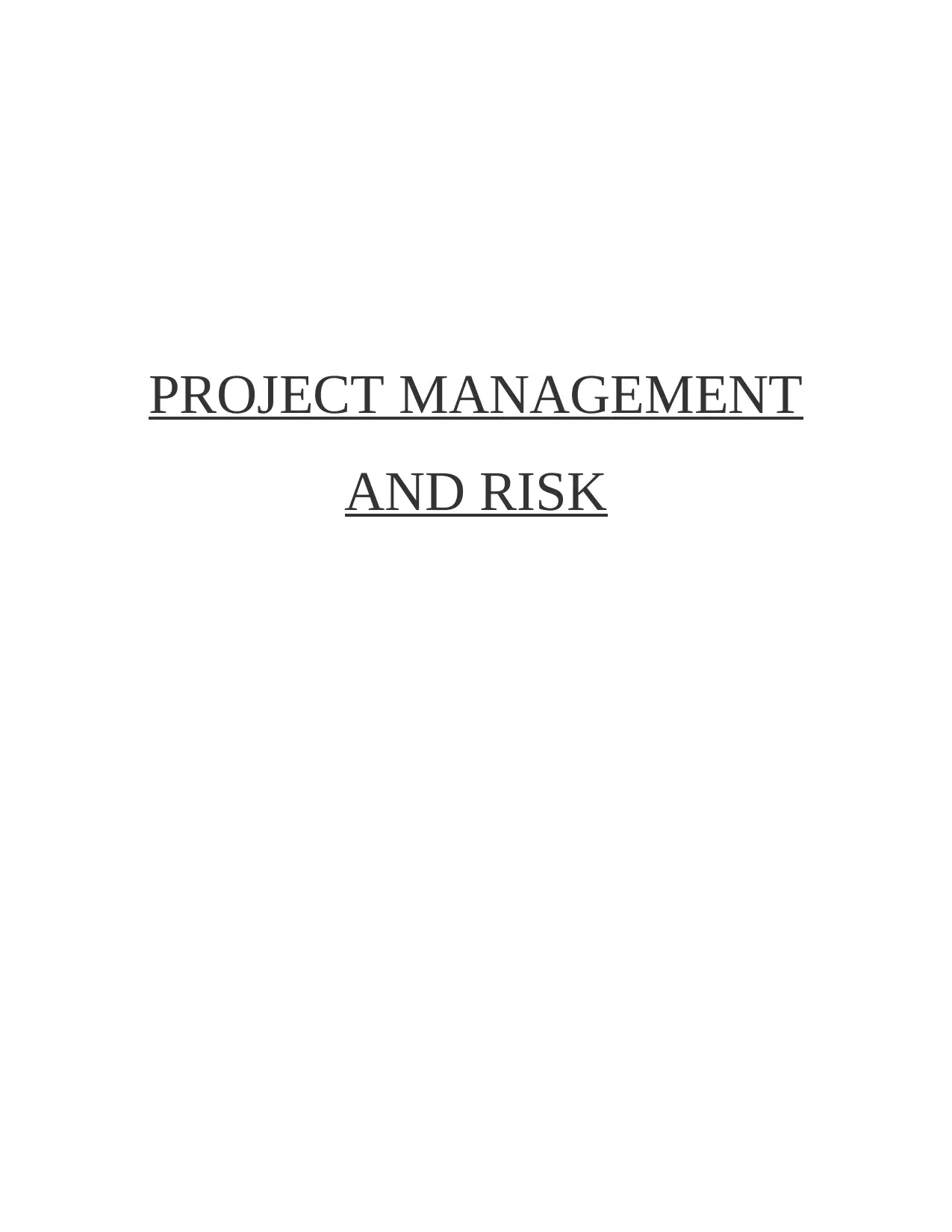
PROJECT MANAGEMENT
AND RISK
AND RISK
Paraphrase This Document
Need a fresh take? Get an instant paraphrase of this document with our AI Paraphraser
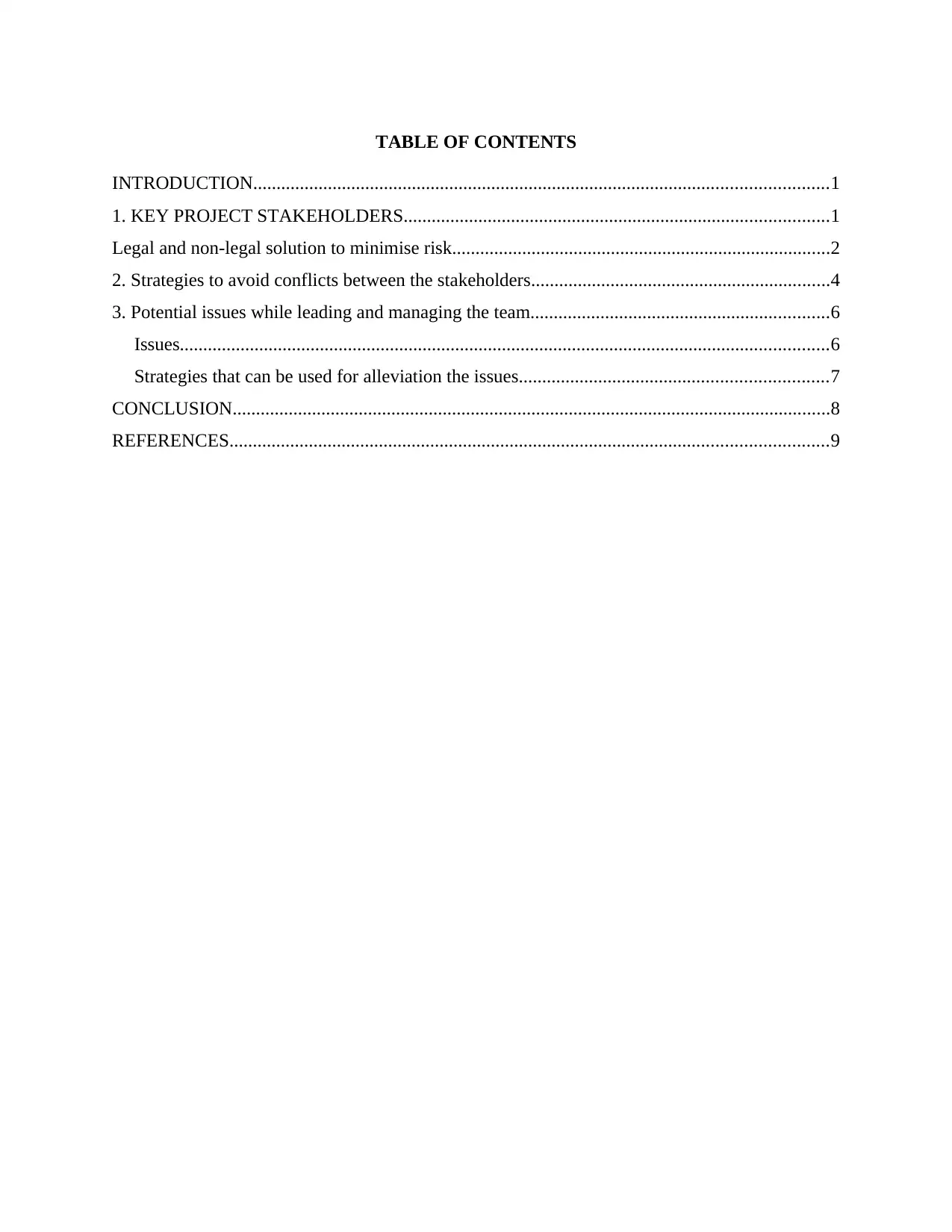
TABLE OF CONTENTS
INTRODUCTION...........................................................................................................................1
1. KEY PROJECT STAKEHOLDERS...........................................................................................1
Legal and non-legal solution to minimise risk.................................................................................2
2. Strategies to avoid conflicts between the stakeholders................................................................4
3. Potential issues while leading and managing the team................................................................6
Issues...........................................................................................................................................6
Strategies that can be used for alleviation the issues..................................................................7
CONCLUSION................................................................................................................................8
REFERENCES................................................................................................................................9
INTRODUCTION...........................................................................................................................1
1. KEY PROJECT STAKEHOLDERS...........................................................................................1
Legal and non-legal solution to minimise risk.................................................................................2
2. Strategies to avoid conflicts between the stakeholders................................................................4
3. Potential issues while leading and managing the team................................................................6
Issues...........................................................................................................................................6
Strategies that can be used for alleviation the issues..................................................................7
CONCLUSION................................................................................................................................8
REFERENCES................................................................................................................................9
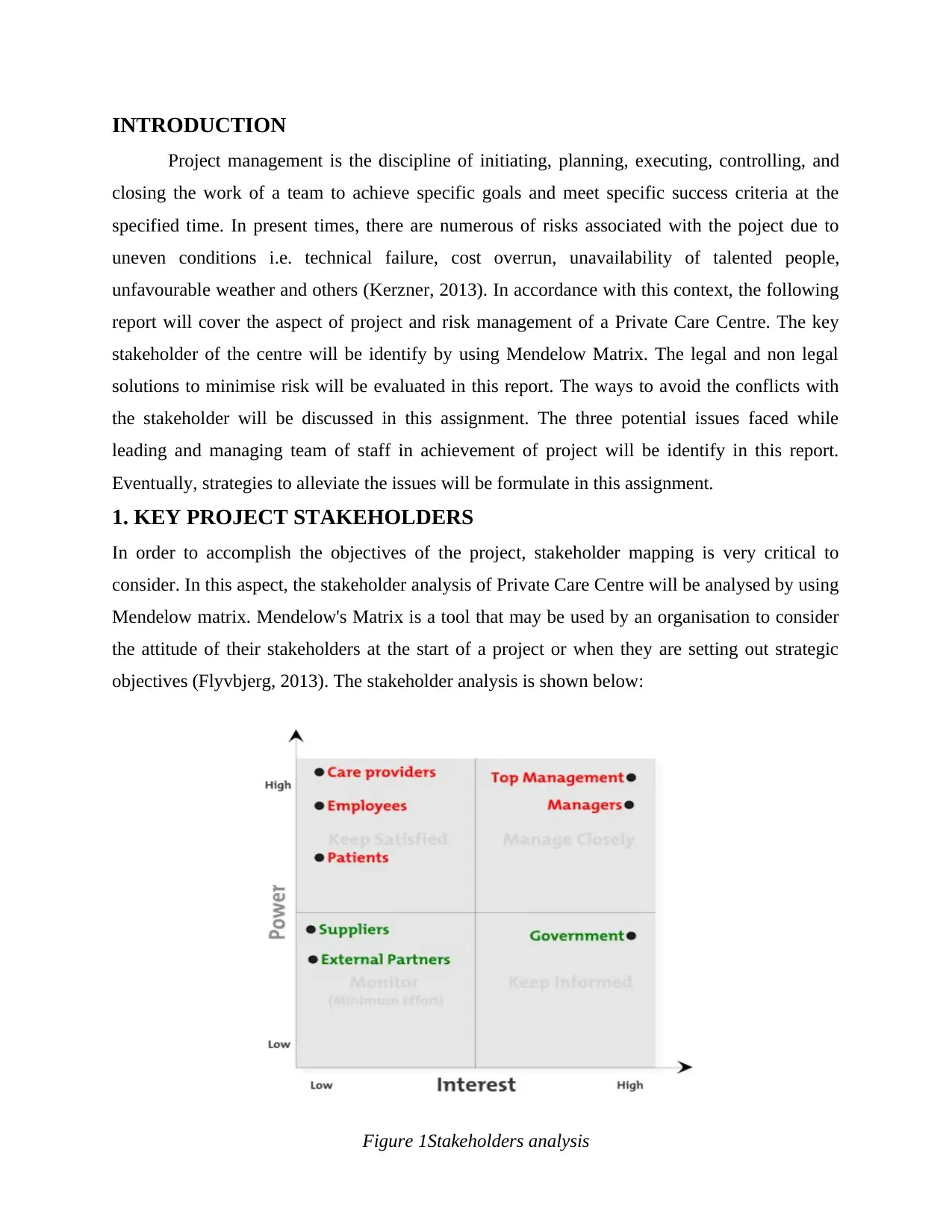
INTRODUCTION
Project management is the discipline of initiating, planning, executing, controlling, and
closing the work of a team to achieve specific goals and meet specific success criteria at the
specified time. In present times, there are numerous of risks associated with the poject due to
uneven conditions i.e. technical failure, cost overrun, unavailability of talented people,
unfavourable weather and others (Kerzner, 2013). In accordance with this context, the following
report will cover the aspect of project and risk management of a Private Care Centre. The key
stakeholder of the centre will be identify by using Mendelow Matrix. The legal and non legal
solutions to minimise risk will be evaluated in this report. The ways to avoid the conflicts with
the stakeholder will be discussed in this assignment. The three potential issues faced while
leading and managing team of staff in achievement of project will be identify in this report.
Eventually, strategies to alleviate the issues will be formulate in this assignment.
1. KEY PROJECT STAKEHOLDERS
In order to accomplish the objectives of the project, stakeholder mapping is very critical to
consider. In this aspect, the stakeholder analysis of Private Care Centre will be analysed by using
Mendelow matrix. Mendelow's Matrix is a tool that may be used by an organisation to consider
the attitude of their stakeholders at the start of a project or when they are setting out strategic
objectives (Flyvbjerg, 2013). The stakeholder analysis is shown below:
1Figure 1Stakeholders analysis
Project management is the discipline of initiating, planning, executing, controlling, and
closing the work of a team to achieve specific goals and meet specific success criteria at the
specified time. In present times, there are numerous of risks associated with the poject due to
uneven conditions i.e. technical failure, cost overrun, unavailability of talented people,
unfavourable weather and others (Kerzner, 2013). In accordance with this context, the following
report will cover the aspect of project and risk management of a Private Care Centre. The key
stakeholder of the centre will be identify by using Mendelow Matrix. The legal and non legal
solutions to minimise risk will be evaluated in this report. The ways to avoid the conflicts with
the stakeholder will be discussed in this assignment. The three potential issues faced while
leading and managing team of staff in achievement of project will be identify in this report.
Eventually, strategies to alleviate the issues will be formulate in this assignment.
1. KEY PROJECT STAKEHOLDERS
In order to accomplish the objectives of the project, stakeholder mapping is very critical to
consider. In this aspect, the stakeholder analysis of Private Care Centre will be analysed by using
Mendelow matrix. Mendelow's Matrix is a tool that may be used by an organisation to consider
the attitude of their stakeholders at the start of a project or when they are setting out strategic
objectives (Flyvbjerg, 2013). The stakeholder analysis is shown below:
1Figure 1Stakeholders analysis
⊘ This is a preview!⊘
Do you want full access?
Subscribe today to unlock all pages.

Trusted by 1+ million students worldwide
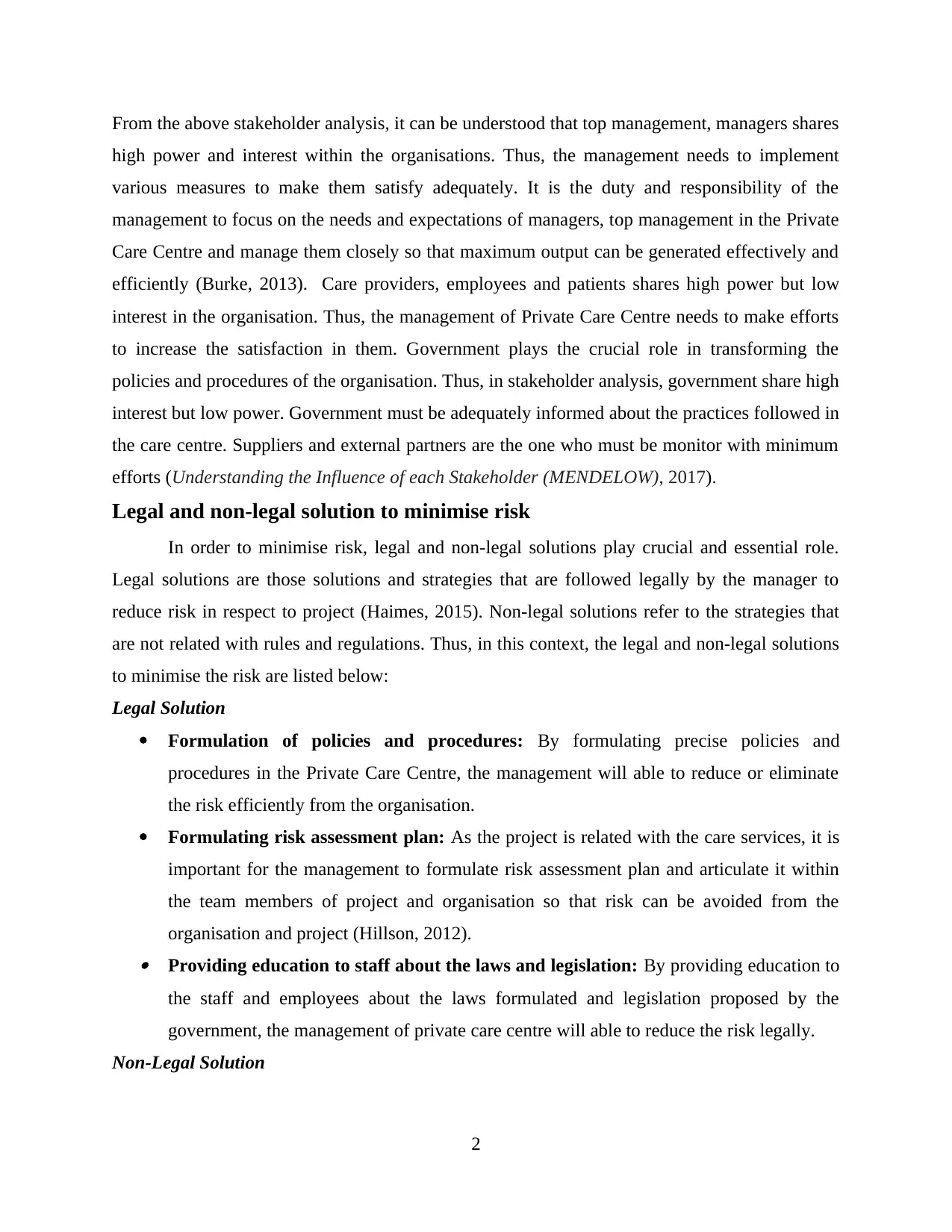
From the above stakeholder analysis, it can be understood that top management, managers shares
high power and interest within the organisations. Thus, the management needs to implement
various measures to make them satisfy adequately. It is the duty and responsibility of the
management to focus on the needs and expectations of managers, top management in the Private
Care Centre and manage them closely so that maximum output can be generated effectively and
efficiently (Burke, 2013). Care providers, employees and patients shares high power but low
interest in the organisation. Thus, the management of Private Care Centre needs to make efforts
to increase the satisfaction in them. Government plays the crucial role in transforming the
policies and procedures of the organisation. Thus, in stakeholder analysis, government share high
interest but low power. Government must be adequately informed about the practices followed in
the care centre. Suppliers and external partners are the one who must be monitor with minimum
efforts (Understanding the Influence of each Stakeholder (MENDELOW), 2017).
Legal and non-legal solution to minimise risk
In order to minimise risk, legal and non-legal solutions play crucial and essential role.
Legal solutions are those solutions and strategies that are followed legally by the manager to
reduce risk in respect to project (Haimes, 2015). Non-legal solutions refer to the strategies that
are not related with rules and regulations. Thus, in this context, the legal and non-legal solutions
to minimise the risk are listed below:
Legal Solution
Formulation of policies and procedures: By formulating precise policies and
procedures in the Private Care Centre, the management will able to reduce or eliminate
the risk efficiently from the organisation.
Formulating risk assessment plan: As the project is related with the care services, it is
important for the management to formulate risk assessment plan and articulate it within
the team members of project and organisation so that risk can be avoided from the
organisation and project (Hillson, 2012). Providing education to staff about the laws and legislation: By providing education to
the staff and employees about the laws formulated and legislation proposed by the
government, the management of private care centre will able to reduce the risk legally.
Non-Legal Solution
2
high power and interest within the organisations. Thus, the management needs to implement
various measures to make them satisfy adequately. It is the duty and responsibility of the
management to focus on the needs and expectations of managers, top management in the Private
Care Centre and manage them closely so that maximum output can be generated effectively and
efficiently (Burke, 2013). Care providers, employees and patients shares high power but low
interest in the organisation. Thus, the management of Private Care Centre needs to make efforts
to increase the satisfaction in them. Government plays the crucial role in transforming the
policies and procedures of the organisation. Thus, in stakeholder analysis, government share high
interest but low power. Government must be adequately informed about the practices followed in
the care centre. Suppliers and external partners are the one who must be monitor with minimum
efforts (Understanding the Influence of each Stakeholder (MENDELOW), 2017).
Legal and non-legal solution to minimise risk
In order to minimise risk, legal and non-legal solutions play crucial and essential role.
Legal solutions are those solutions and strategies that are followed legally by the manager to
reduce risk in respect to project (Haimes, 2015). Non-legal solutions refer to the strategies that
are not related with rules and regulations. Thus, in this context, the legal and non-legal solutions
to minimise the risk are listed below:
Legal Solution
Formulation of policies and procedures: By formulating precise policies and
procedures in the Private Care Centre, the management will able to reduce or eliminate
the risk efficiently from the organisation.
Formulating risk assessment plan: As the project is related with the care services, it is
important for the management to formulate risk assessment plan and articulate it within
the team members of project and organisation so that risk can be avoided from the
organisation and project (Hillson, 2012). Providing education to staff about the laws and legislation: By providing education to
the staff and employees about the laws formulated and legislation proposed by the
government, the management of private care centre will able to reduce the risk legally.
Non-Legal Solution
2
Paraphrase This Document
Need a fresh take? Get an instant paraphrase of this document with our AI Paraphraser
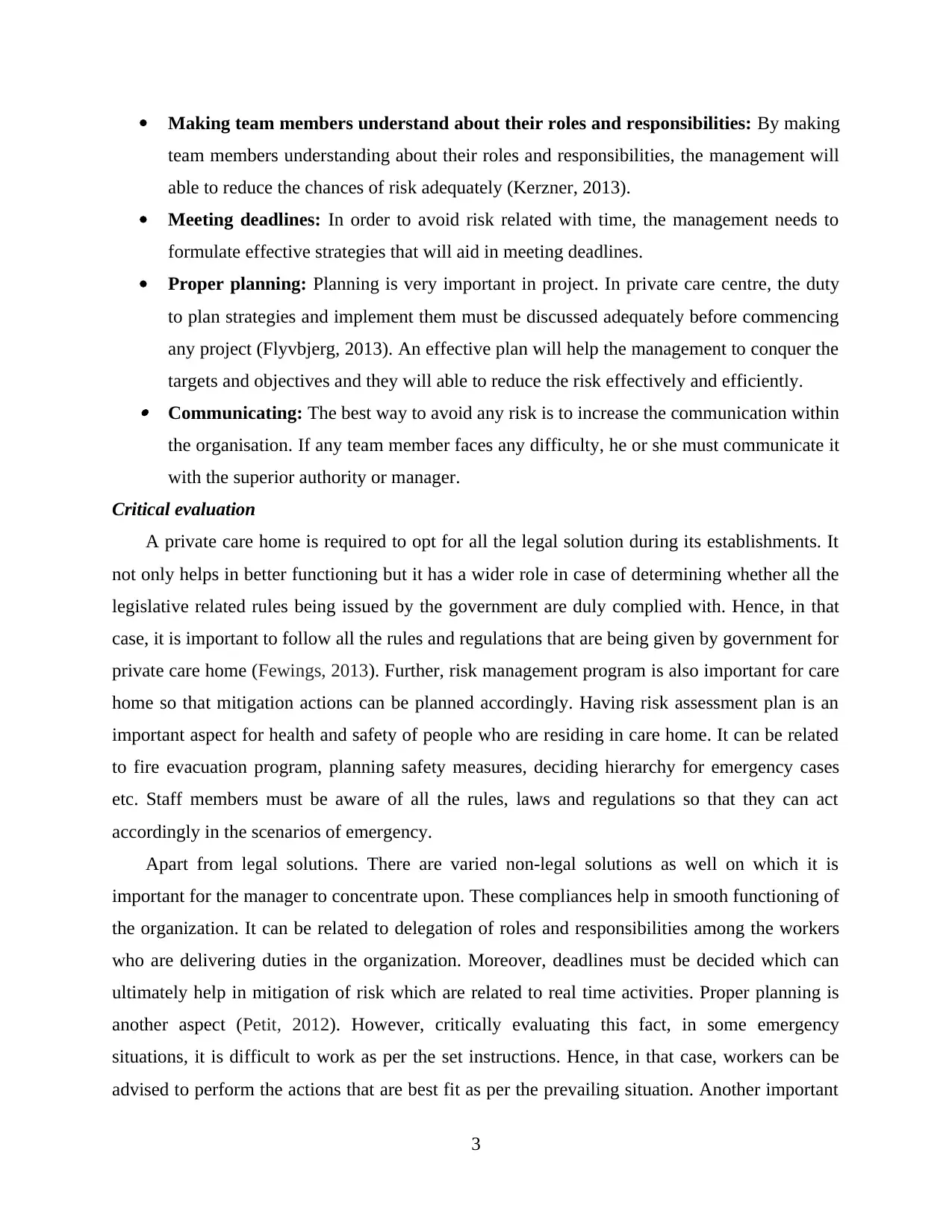
Making team members understand about their roles and responsibilities: By making
team members understanding about their roles and responsibilities, the management will
able to reduce the chances of risk adequately (Kerzner, 2013).
Meeting deadlines: In order to avoid risk related with time, the management needs to
formulate effective strategies that will aid in meeting deadlines.
Proper planning: Planning is very important in project. In private care centre, the duty
to plan strategies and implement them must be discussed adequately before commencing
any project (Flyvbjerg, 2013). An effective plan will help the management to conquer the
targets and objectives and they will able to reduce the risk effectively and efficiently. Communicating: The best way to avoid any risk is to increase the communication within
the organisation. If any team member faces any difficulty, he or she must communicate it
with the superior authority or manager.
Critical evaluation
A private care home is required to opt for all the legal solution during its establishments. It
not only helps in better functioning but it has a wider role in case of determining whether all the
legislative related rules being issued by the government are duly complied with. Hence, in that
case, it is important to follow all the rules and regulations that are being given by government for
private care home (Fewings, 2013). Further, risk management program is also important for care
home so that mitigation actions can be planned accordingly. Having risk assessment plan is an
important aspect for health and safety of people who are residing in care home. It can be related
to fire evacuation program, planning safety measures, deciding hierarchy for emergency cases
etc. Staff members must be aware of all the rules, laws and regulations so that they can act
accordingly in the scenarios of emergency.
Apart from legal solutions. There are varied non-legal solutions as well on which it is
important for the manager to concentrate upon. These compliances help in smooth functioning of
the organization. It can be related to delegation of roles and responsibilities among the workers
who are delivering duties in the organization. Moreover, deadlines must be decided which can
ultimately help in mitigation of risk which are related to real time activities. Proper planning is
another aspect (Petit, 2012). However, critically evaluating this fact, in some emergency
situations, it is difficult to work as per the set instructions. Hence, in that case, workers can be
advised to perform the actions that are best fit as per the prevailing situation. Another important
3
team members understanding about their roles and responsibilities, the management will
able to reduce the chances of risk adequately (Kerzner, 2013).
Meeting deadlines: In order to avoid risk related with time, the management needs to
formulate effective strategies that will aid in meeting deadlines.
Proper planning: Planning is very important in project. In private care centre, the duty
to plan strategies and implement them must be discussed adequately before commencing
any project (Flyvbjerg, 2013). An effective plan will help the management to conquer the
targets and objectives and they will able to reduce the risk effectively and efficiently. Communicating: The best way to avoid any risk is to increase the communication within
the organisation. If any team member faces any difficulty, he or she must communicate it
with the superior authority or manager.
Critical evaluation
A private care home is required to opt for all the legal solution during its establishments. It
not only helps in better functioning but it has a wider role in case of determining whether all the
legislative related rules being issued by the government are duly complied with. Hence, in that
case, it is important to follow all the rules and regulations that are being given by government for
private care home (Fewings, 2013). Further, risk management program is also important for care
home so that mitigation actions can be planned accordingly. Having risk assessment plan is an
important aspect for health and safety of people who are residing in care home. It can be related
to fire evacuation program, planning safety measures, deciding hierarchy for emergency cases
etc. Staff members must be aware of all the rules, laws and regulations so that they can act
accordingly in the scenarios of emergency.
Apart from legal solutions. There are varied non-legal solutions as well on which it is
important for the manager to concentrate upon. These compliances help in smooth functioning of
the organization. It can be related to delegation of roles and responsibilities among the workers
who are delivering duties in the organization. Moreover, deadlines must be decided which can
ultimately help in mitigation of risk which are related to real time activities. Proper planning is
another aspect (Petit, 2012). However, critically evaluating this fact, in some emergency
situations, it is difficult to work as per the set instructions. Hence, in that case, workers can be
advised to perform the actions that are best fit as per the prevailing situation. Another important
3
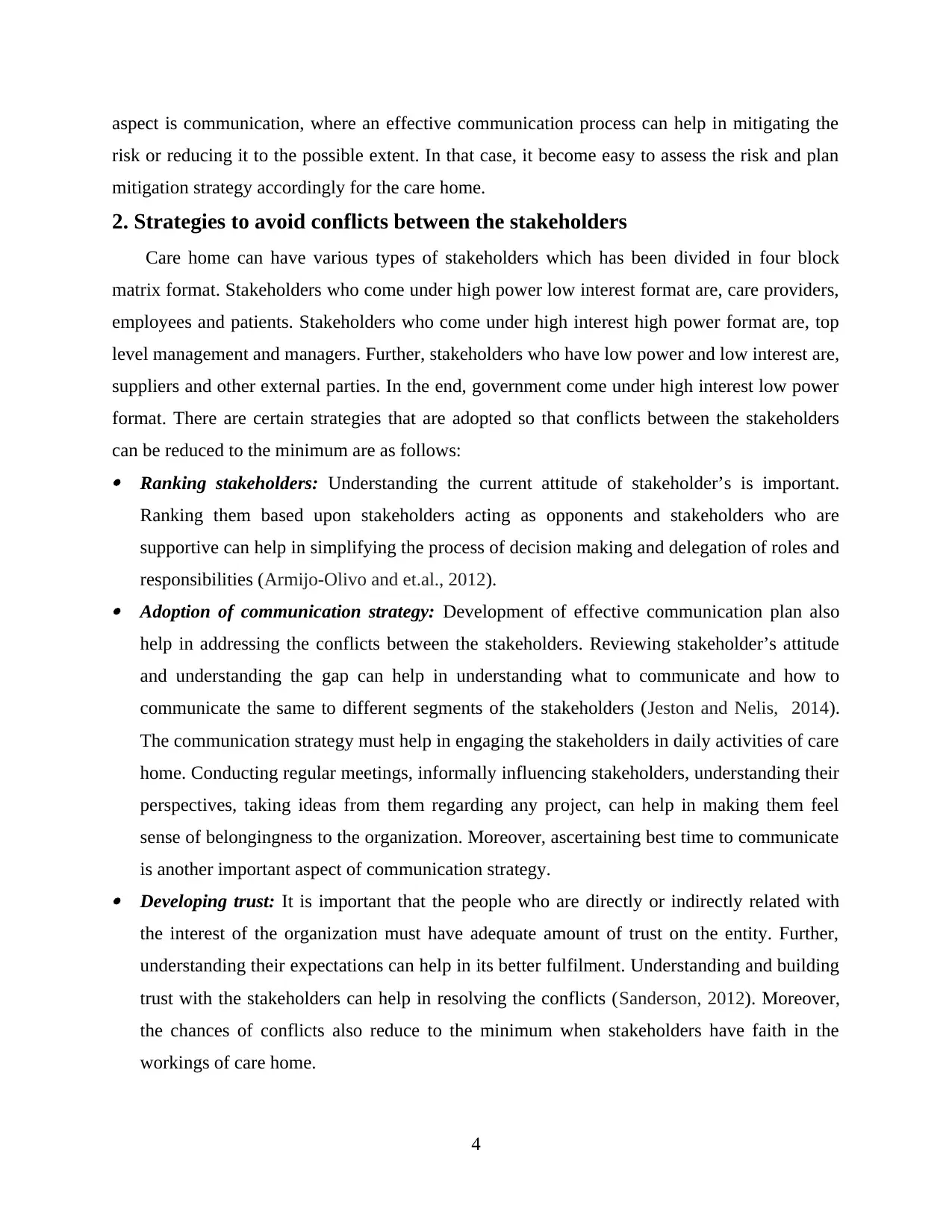
aspect is communication, where an effective communication process can help in mitigating the
risk or reducing it to the possible extent. In that case, it become easy to assess the risk and plan
mitigation strategy accordingly for the care home.
2. Strategies to avoid conflicts between the stakeholders
Care home can have various types of stakeholders which has been divided in four block
matrix format. Stakeholders who come under high power low interest format are, care providers,
employees and patients. Stakeholders who come under high interest high power format are, top
level management and managers. Further, stakeholders who have low power and low interest are,
suppliers and other external parties. In the end, government come under high interest low power
format. There are certain strategies that are adopted so that conflicts between the stakeholders
can be reduced to the minimum are as follows: Ranking stakeholders: Understanding the current attitude of stakeholder’s is important.
Ranking them based upon stakeholders acting as opponents and stakeholders who are
supportive can help in simplifying the process of decision making and delegation of roles and
responsibilities (Armijo‐Olivo and et.al., 2012). Adoption of communication strategy: Development of effective communication plan also
help in addressing the conflicts between the stakeholders. Reviewing stakeholder’s attitude
and understanding the gap can help in understanding what to communicate and how to
communicate the same to different segments of the stakeholders (Jeston and Nelis, 2014).
The communication strategy must help in engaging the stakeholders in daily activities of care
home. Conducting regular meetings, informally influencing stakeholders, understanding their
perspectives, taking ideas from them regarding any project, can help in making them feel
sense of belongingness to the organization. Moreover, ascertaining best time to communicate
is another important aspect of communication strategy. Developing trust: It is important that the people who are directly or indirectly related with
the interest of the organization must have adequate amount of trust on the entity. Further,
understanding their expectations can help in its better fulfilment. Understanding and building
trust with the stakeholders can help in resolving the conflicts (Sanderson, 2012). Moreover,
the chances of conflicts also reduce to the minimum when stakeholders have faith in the
workings of care home.
4
risk or reducing it to the possible extent. In that case, it become easy to assess the risk and plan
mitigation strategy accordingly for the care home.
2. Strategies to avoid conflicts between the stakeholders
Care home can have various types of stakeholders which has been divided in four block
matrix format. Stakeholders who come under high power low interest format are, care providers,
employees and patients. Stakeholders who come under high interest high power format are, top
level management and managers. Further, stakeholders who have low power and low interest are,
suppliers and other external parties. In the end, government come under high interest low power
format. There are certain strategies that are adopted so that conflicts between the stakeholders
can be reduced to the minimum are as follows: Ranking stakeholders: Understanding the current attitude of stakeholder’s is important.
Ranking them based upon stakeholders acting as opponents and stakeholders who are
supportive can help in simplifying the process of decision making and delegation of roles and
responsibilities (Armijo‐Olivo and et.al., 2012). Adoption of communication strategy: Development of effective communication plan also
help in addressing the conflicts between the stakeholders. Reviewing stakeholder’s attitude
and understanding the gap can help in understanding what to communicate and how to
communicate the same to different segments of the stakeholders (Jeston and Nelis, 2014).
The communication strategy must help in engaging the stakeholders in daily activities of care
home. Conducting regular meetings, informally influencing stakeholders, understanding their
perspectives, taking ideas from them regarding any project, can help in making them feel
sense of belongingness to the organization. Moreover, ascertaining best time to communicate
is another important aspect of communication strategy. Developing trust: It is important that the people who are directly or indirectly related with
the interest of the organization must have adequate amount of trust on the entity. Further,
understanding their expectations can help in its better fulfilment. Understanding and building
trust with the stakeholders can help in resolving the conflicts (Sanderson, 2012). Moreover,
the chances of conflicts also reduce to the minimum when stakeholders have faith in the
workings of care home.
4
⊘ This is a preview!⊘
Do you want full access?
Subscribe today to unlock all pages.

Trusted by 1+ million students worldwide
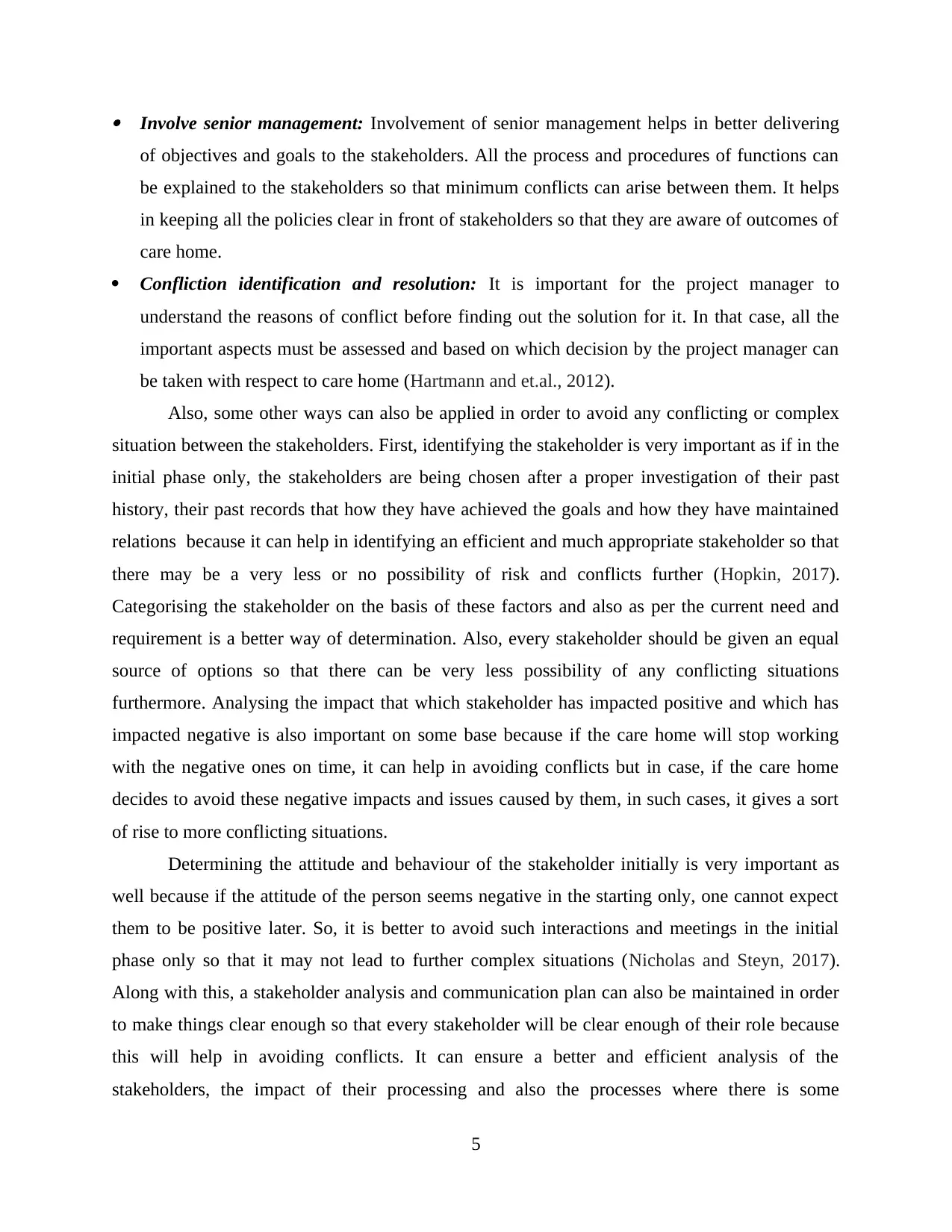
Involve senior management: Involvement of senior management helps in better delivering
of objectives and goals to the stakeholders. All the process and procedures of functions can
be explained to the stakeholders so that minimum conflicts can arise between them. It helps
in keeping all the policies clear in front of stakeholders so that they are aware of outcomes of
care home.
Confliction identification and resolution: It is important for the project manager to
understand the reasons of conflict before finding out the solution for it. In that case, all the
important aspects must be assessed and based on which decision by the project manager can
be taken with respect to care home (Hartmann and et.al., 2012).
Also, some other ways can also be applied in order to avoid any conflicting or complex
situation between the stakeholders. First, identifying the stakeholder is very important as if in the
initial phase only, the stakeholders are being chosen after a proper investigation of their past
history, their past records that how they have achieved the goals and how they have maintained
relations because it can help in identifying an efficient and much appropriate stakeholder so that
there may be a very less or no possibility of risk and conflicts further (Hopkin, 2017).
Categorising the stakeholder on the basis of these factors and also as per the current need and
requirement is a better way of determination. Also, every stakeholder should be given an equal
source of options so that there can be very less possibility of any conflicting situations
furthermore. Analysing the impact that which stakeholder has impacted positive and which has
impacted negative is also important on some base because if the care home will stop working
with the negative ones on time, it can help in avoiding conflicts but in case, if the care home
decides to avoid these negative impacts and issues caused by them, in such cases, it gives a sort
of rise to more conflicting situations.
Determining the attitude and behaviour of the stakeholder initially is very important as
well because if the attitude of the person seems negative in the starting only, one cannot expect
them to be positive later. So, it is better to avoid such interactions and meetings in the initial
phase only so that it may not lead to further complex situations (Nicholas and Steyn, 2017).
Along with this, a stakeholder analysis and communication plan can also be maintained in order
to make things clear enough so that every stakeholder will be clear enough of their role because
this will help in avoiding conflicts. It can ensure a better and efficient analysis of the
stakeholders, the impact of their processing and also the processes where there is some
5
of objectives and goals to the stakeholders. All the process and procedures of functions can
be explained to the stakeholders so that minimum conflicts can arise between them. It helps
in keeping all the policies clear in front of stakeholders so that they are aware of outcomes of
care home.
Confliction identification and resolution: It is important for the project manager to
understand the reasons of conflict before finding out the solution for it. In that case, all the
important aspects must be assessed and based on which decision by the project manager can
be taken with respect to care home (Hartmann and et.al., 2012).
Also, some other ways can also be applied in order to avoid any conflicting or complex
situation between the stakeholders. First, identifying the stakeholder is very important as if in the
initial phase only, the stakeholders are being chosen after a proper investigation of their past
history, their past records that how they have achieved the goals and how they have maintained
relations because it can help in identifying an efficient and much appropriate stakeholder so that
there may be a very less or no possibility of risk and conflicts further (Hopkin, 2017).
Categorising the stakeholder on the basis of these factors and also as per the current need and
requirement is a better way of determination. Also, every stakeholder should be given an equal
source of options so that there can be very less possibility of any conflicting situations
furthermore. Analysing the impact that which stakeholder has impacted positive and which has
impacted negative is also important on some base because if the care home will stop working
with the negative ones on time, it can help in avoiding conflicts but in case, if the care home
decides to avoid these negative impacts and issues caused by them, in such cases, it gives a sort
of rise to more conflicting situations.
Determining the attitude and behaviour of the stakeholder initially is very important as
well because if the attitude of the person seems negative in the starting only, one cannot expect
them to be positive later. So, it is better to avoid such interactions and meetings in the initial
phase only so that it may not lead to further complex situations (Nicholas and Steyn, 2017).
Along with this, a stakeholder analysis and communication plan can also be maintained in order
to make things clear enough so that every stakeholder will be clear enough of their role because
this will help in avoiding conflicts. It can ensure a better and efficient analysis of the
stakeholders, the impact of their processing and also the processes where there is some
5
Paraphrase This Document
Need a fresh take? Get an instant paraphrase of this document with our AI Paraphraser
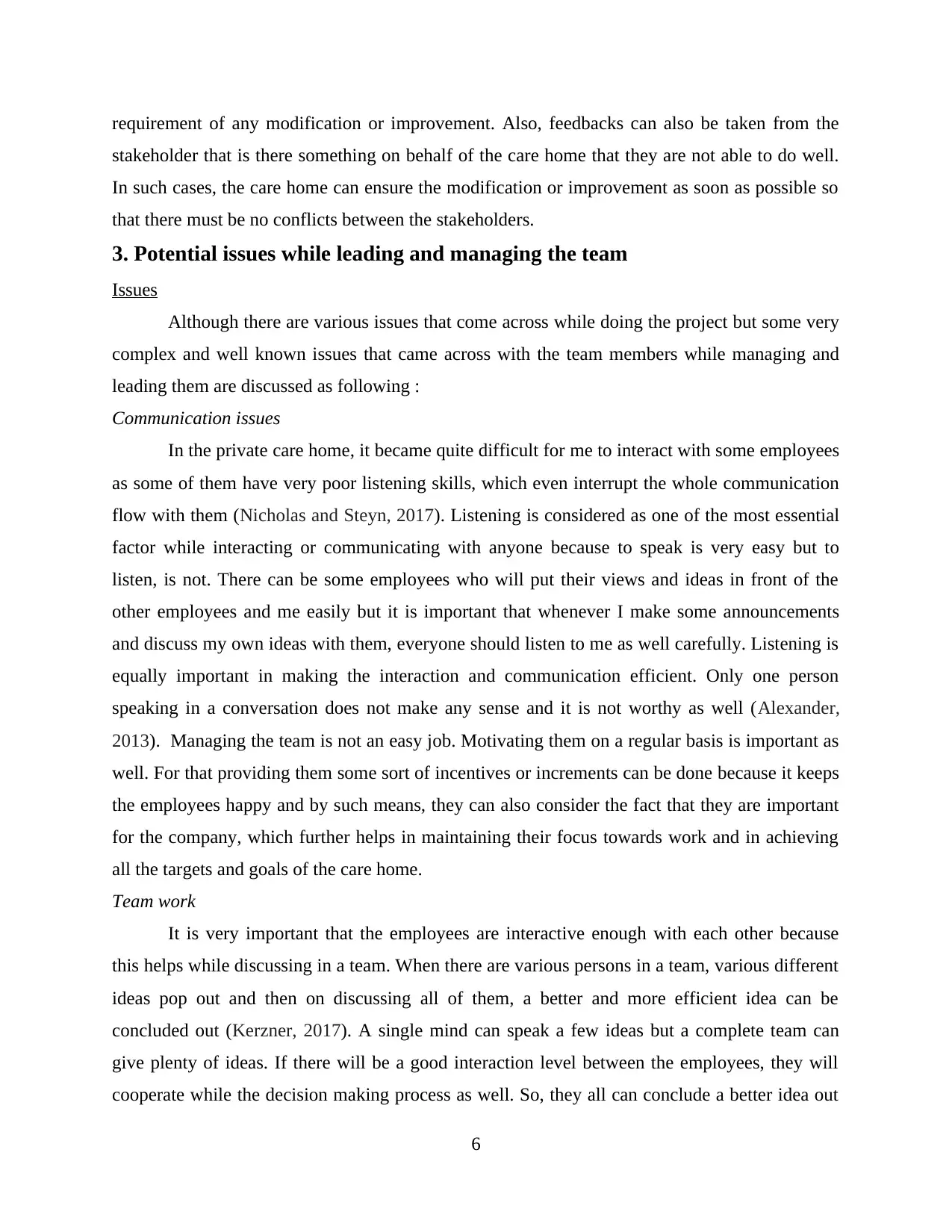
requirement of any modification or improvement. Also, feedbacks can also be taken from the
stakeholder that is there something on behalf of the care home that they are not able to do well.
In such cases, the care home can ensure the modification or improvement as soon as possible so
that there must be no conflicts between the stakeholders.
3. Potential issues while leading and managing the team
Issues
Although there are various issues that come across while doing the project but some very
complex and well known issues that came across with the team members while managing and
leading them are discussed as following :
Communication issues
In the private care home, it became quite difficult for me to interact with some employees
as some of them have very poor listening skills, which even interrupt the whole communication
flow with them (Nicholas and Steyn, 2017). Listening is considered as one of the most essential
factor while interacting or communicating with anyone because to speak is very easy but to
listen, is not. There can be some employees who will put their views and ideas in front of the
other employees and me easily but it is important that whenever I make some announcements
and discuss my own ideas with them, everyone should listen to me as well carefully. Listening is
equally important in making the interaction and communication efficient. Only one person
speaking in a conversation does not make any sense and it is not worthy as well (Alexander,
2013). Managing the team is not an easy job. Motivating them on a regular basis is important as
well. For that providing them some sort of incentives or increments can be done because it keeps
the employees happy and by such means, they can also consider the fact that they are important
for the company, which further helps in maintaining their focus towards work and in achieving
all the targets and goals of the care home.
Team work
It is very important that the employees are interactive enough with each other because
this helps while discussing in a team. When there are various persons in a team, various different
ideas pop out and then on discussing all of them, a better and more efficient idea can be
concluded out (Kerzner, 2017). A single mind can speak a few ideas but a complete team can
give plenty of ideas. If there will be a good interaction level between the employees, they will
cooperate while the decision making process as well. So, they all can conclude a better idea out
6
stakeholder that is there something on behalf of the care home that they are not able to do well.
In such cases, the care home can ensure the modification or improvement as soon as possible so
that there must be no conflicts between the stakeholders.
3. Potential issues while leading and managing the team
Issues
Although there are various issues that come across while doing the project but some very
complex and well known issues that came across with the team members while managing and
leading them are discussed as following :
Communication issues
In the private care home, it became quite difficult for me to interact with some employees
as some of them have very poor listening skills, which even interrupt the whole communication
flow with them (Nicholas and Steyn, 2017). Listening is considered as one of the most essential
factor while interacting or communicating with anyone because to speak is very easy but to
listen, is not. There can be some employees who will put their views and ideas in front of the
other employees and me easily but it is important that whenever I make some announcements
and discuss my own ideas with them, everyone should listen to me as well carefully. Listening is
equally important in making the interaction and communication efficient. Only one person
speaking in a conversation does not make any sense and it is not worthy as well (Alexander,
2013). Managing the team is not an easy job. Motivating them on a regular basis is important as
well. For that providing them some sort of incentives or increments can be done because it keeps
the employees happy and by such means, they can also consider the fact that they are important
for the company, which further helps in maintaining their focus towards work and in achieving
all the targets and goals of the care home.
Team work
It is very important that the employees are interactive enough with each other because
this helps while discussing in a team. When there are various persons in a team, various different
ideas pop out and then on discussing all of them, a better and more efficient idea can be
concluded out (Kerzner, 2017). A single mind can speak a few ideas but a complete team can
give plenty of ideas. If there will be a good interaction level between the employees, they will
cooperate while the decision making process as well. So, they all can conclude a better idea out
6
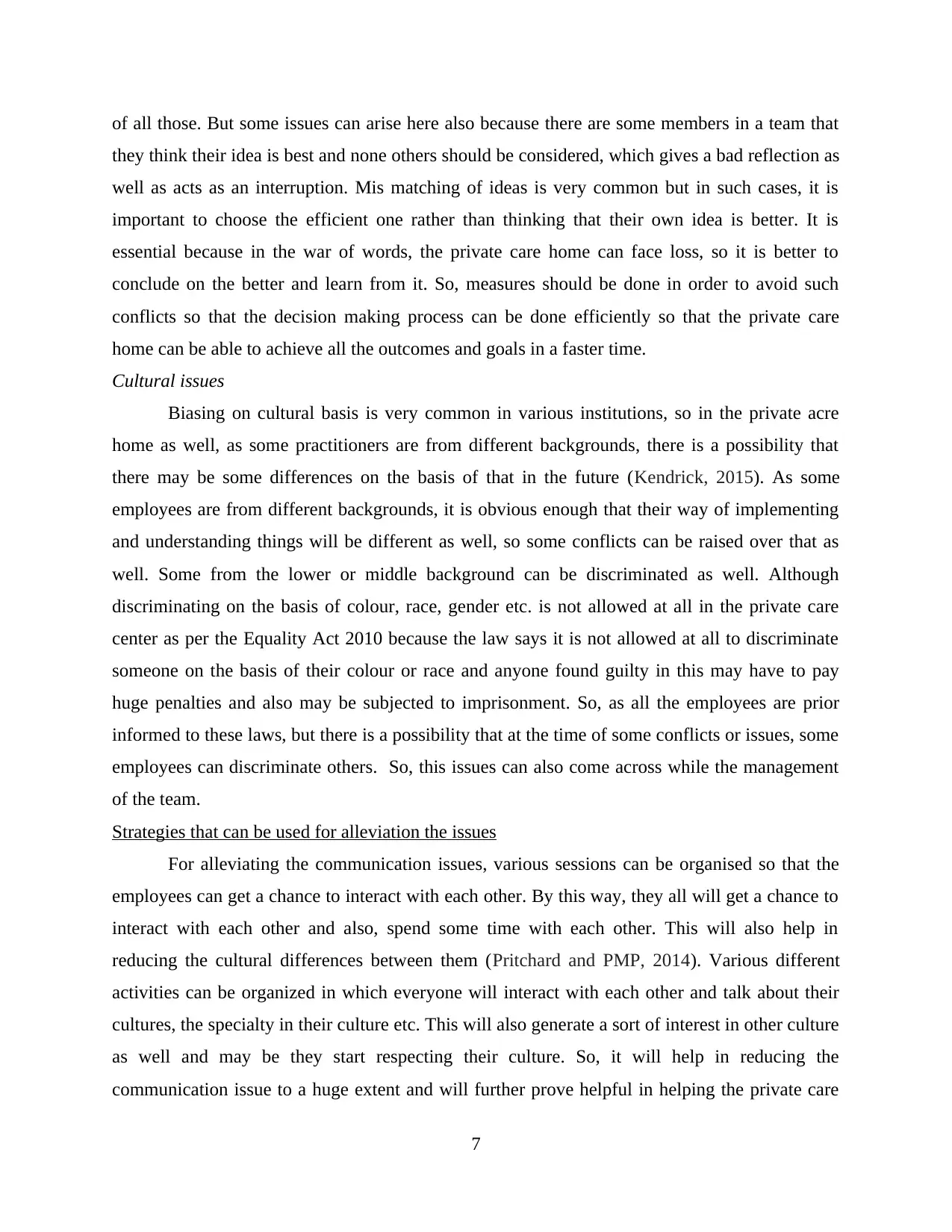
of all those. But some issues can arise here also because there are some members in a team that
they think their idea is best and none others should be considered, which gives a bad reflection as
well as acts as an interruption. Mis matching of ideas is very common but in such cases, it is
important to choose the efficient one rather than thinking that their own idea is better. It is
essential because in the war of words, the private care home can face loss, so it is better to
conclude on the better and learn from it. So, measures should be done in order to avoid such
conflicts so that the decision making process can be done efficiently so that the private care
home can be able to achieve all the outcomes and goals in a faster time.
Cultural issues
Biasing on cultural basis is very common in various institutions, so in the private acre
home as well, as some practitioners are from different backgrounds, there is a possibility that
there may be some differences on the basis of that in the future (Kendrick, 2015). As some
employees are from different backgrounds, it is obvious enough that their way of implementing
and understanding things will be different as well, so some conflicts can be raised over that as
well. Some from the lower or middle background can be discriminated as well. Although
discriminating on the basis of colour, race, gender etc. is not allowed at all in the private care
center as per the Equality Act 2010 because the law says it is not allowed at all to discriminate
someone on the basis of their colour or race and anyone found guilty in this may have to pay
huge penalties and also may be subjected to imprisonment. So, as all the employees are prior
informed to these laws, but there is a possibility that at the time of some conflicts or issues, some
employees can discriminate others. So, this issues can also come across while the management
of the team.
Strategies that can be used for alleviation the issues
For alleviating the communication issues, various sessions can be organised so that the
employees can get a chance to interact with each other. By this way, they all will get a chance to
interact with each other and also, spend some time with each other. This will also help in
reducing the cultural differences between them (Pritchard and PMP, 2014). Various different
activities can be organized in which everyone will interact with each other and talk about their
cultures, the specialty in their culture etc. This will also generate a sort of interest in other culture
as well and may be they start respecting their culture. So, it will help in reducing the
communication issue to a huge extent and will further prove helpful in helping the private care
7
they think their idea is best and none others should be considered, which gives a bad reflection as
well as acts as an interruption. Mis matching of ideas is very common but in such cases, it is
important to choose the efficient one rather than thinking that their own idea is better. It is
essential because in the war of words, the private care home can face loss, so it is better to
conclude on the better and learn from it. So, measures should be done in order to avoid such
conflicts so that the decision making process can be done efficiently so that the private care
home can be able to achieve all the outcomes and goals in a faster time.
Cultural issues
Biasing on cultural basis is very common in various institutions, so in the private acre
home as well, as some practitioners are from different backgrounds, there is a possibility that
there may be some differences on the basis of that in the future (Kendrick, 2015). As some
employees are from different backgrounds, it is obvious enough that their way of implementing
and understanding things will be different as well, so some conflicts can be raised over that as
well. Some from the lower or middle background can be discriminated as well. Although
discriminating on the basis of colour, race, gender etc. is not allowed at all in the private care
center as per the Equality Act 2010 because the law says it is not allowed at all to discriminate
someone on the basis of their colour or race and anyone found guilty in this may have to pay
huge penalties and also may be subjected to imprisonment. So, as all the employees are prior
informed to these laws, but there is a possibility that at the time of some conflicts or issues, some
employees can discriminate others. So, this issues can also come across while the management
of the team.
Strategies that can be used for alleviation the issues
For alleviating the communication issues, various sessions can be organised so that the
employees can get a chance to interact with each other. By this way, they all will get a chance to
interact with each other and also, spend some time with each other. This will also help in
reducing the cultural differences between them (Pritchard and PMP, 2014). Various different
activities can be organized in which everyone will interact with each other and talk about their
cultures, the specialty in their culture etc. This will also generate a sort of interest in other culture
as well and may be they start respecting their culture. So, it will help in reducing the
communication issue to a huge extent and will further prove helpful in helping the private care
7
⊘ This is a preview!⊘
Do you want full access?
Subscribe today to unlock all pages.

Trusted by 1+ million students worldwide
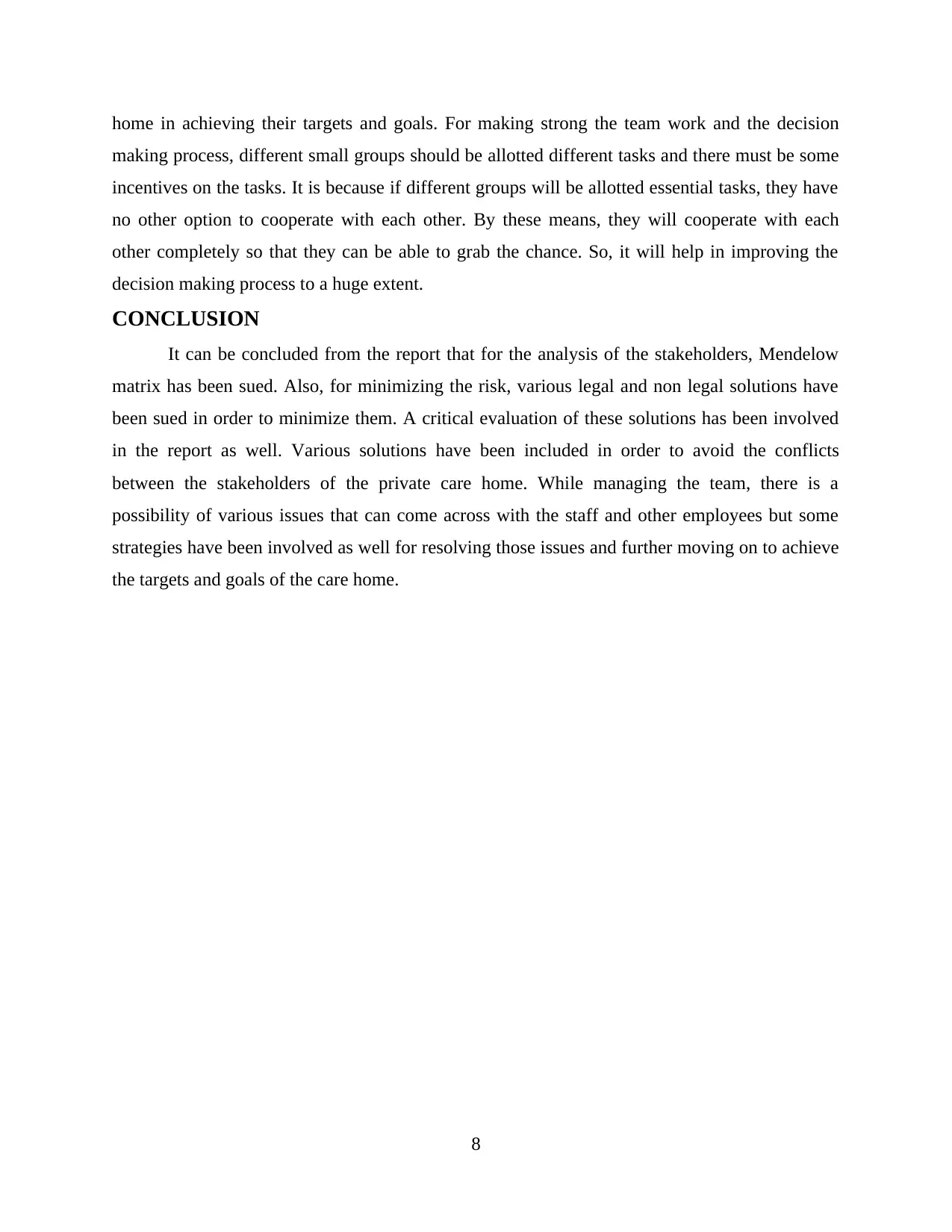
home in achieving their targets and goals. For making strong the team work and the decision
making process, different small groups should be allotted different tasks and there must be some
incentives on the tasks. It is because if different groups will be allotted essential tasks, they have
no other option to cooperate with each other. By these means, they will cooperate with each
other completely so that they can be able to grab the chance. So, it will help in improving the
decision making process to a huge extent.
CONCLUSION
It can be concluded from the report that for the analysis of the stakeholders, Mendelow
matrix has been sued. Also, for minimizing the risk, various legal and non legal solutions have
been sued in order to minimize them. A critical evaluation of these solutions has been involved
in the report as well. Various solutions have been included in order to avoid the conflicts
between the stakeholders of the private care home. While managing the team, there is a
possibility of various issues that can come across with the staff and other employees but some
strategies have been involved as well for resolving those issues and further moving on to achieve
the targets and goals of the care home.
8
making process, different small groups should be allotted different tasks and there must be some
incentives on the tasks. It is because if different groups will be allotted essential tasks, they have
no other option to cooperate with each other. By these means, they will cooperate with each
other completely so that they can be able to grab the chance. So, it will help in improving the
decision making process to a huge extent.
CONCLUSION
It can be concluded from the report that for the analysis of the stakeholders, Mendelow
matrix has been sued. Also, for minimizing the risk, various legal and non legal solutions have
been sued in order to minimize them. A critical evaluation of these solutions has been involved
in the report as well. Various solutions have been included in order to avoid the conflicts
between the stakeholders of the private care home. While managing the team, there is a
possibility of various issues that can come across with the staff and other employees but some
strategies have been involved as well for resolving those issues and further moving on to achieve
the targets and goals of the care home.
8
Paraphrase This Document
Need a fresh take? Get an instant paraphrase of this document with our AI Paraphraser
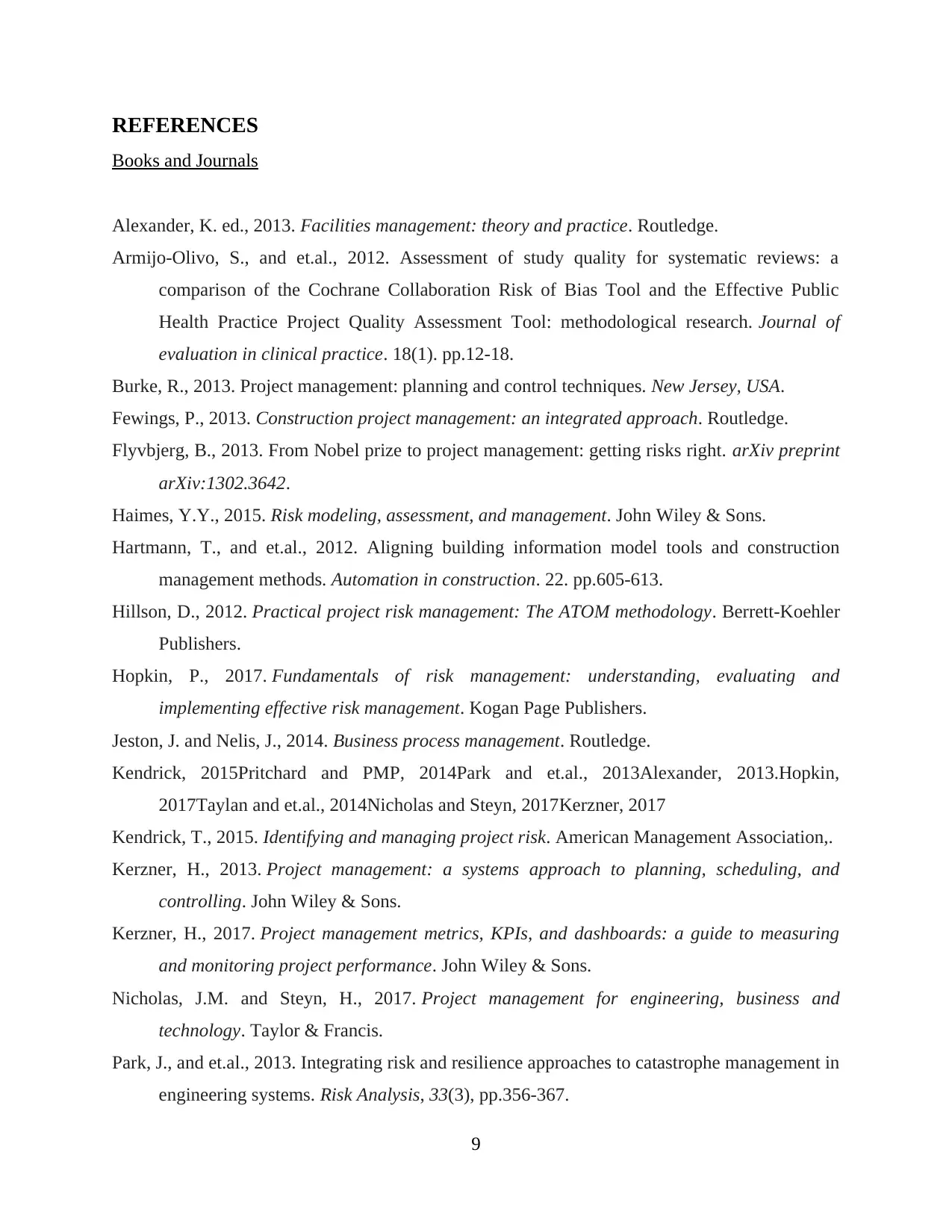
REFERENCES
Books and Journals
Alexander, K. ed., 2013. Facilities management: theory and practice. Routledge.
Armijo‐Olivo, S., and et.al., 2012. Assessment of study quality for systematic reviews: a
comparison of the Cochrane Collaboration Risk of Bias Tool and the Effective Public
Health Practice Project Quality Assessment Tool: methodological research. Journal of
evaluation in clinical practice. 18(1). pp.12-18.
Burke, R., 2013. Project management: planning and control techniques. New Jersey, USA.
Fewings, P., 2013. Construction project management: an integrated approach. Routledge.
Flyvbjerg, B., 2013. From Nobel prize to project management: getting risks right. arXiv preprint
arXiv:1302.3642.
Haimes, Y.Y., 2015. Risk modeling, assessment, and management. John Wiley & Sons.
Hartmann, T., and et.al., 2012. Aligning building information model tools and construction
management methods. Automation in construction. 22. pp.605-613.
Hillson, D., 2012. Practical project risk management: The ATOM methodology. Berrett-Koehler
Publishers.
Hopkin, P., 2017. Fundamentals of risk management: understanding, evaluating and
implementing effective risk management. Kogan Page Publishers.
Jeston, J. and Nelis, J., 2014. Business process management. Routledge.
Kendrick, 2015Pritchard and PMP, 2014Park and et.al., 2013Alexander, 2013.Hopkin,
2017Taylan and et.al., 2014Nicholas and Steyn, 2017Kerzner, 2017
Kendrick, T., 2015. Identifying and managing project risk. American Management Association,.
Kerzner, H., 2013. Project management: a systems approach to planning, scheduling, and
controlling. John Wiley & Sons.
Kerzner, H., 2017. Project management metrics, KPIs, and dashboards: a guide to measuring
and monitoring project performance. John Wiley & Sons.
Nicholas, J.M. and Steyn, H., 2017. Project management for engineering, business and
technology. Taylor & Francis.
Park, J., and et.al., 2013. Integrating risk and resilience approaches to catastrophe management in
engineering systems. Risk Analysis, 33(3), pp.356-367.
9
Books and Journals
Alexander, K. ed., 2013. Facilities management: theory and practice. Routledge.
Armijo‐Olivo, S., and et.al., 2012. Assessment of study quality for systematic reviews: a
comparison of the Cochrane Collaboration Risk of Bias Tool and the Effective Public
Health Practice Project Quality Assessment Tool: methodological research. Journal of
evaluation in clinical practice. 18(1). pp.12-18.
Burke, R., 2013. Project management: planning and control techniques. New Jersey, USA.
Fewings, P., 2013. Construction project management: an integrated approach. Routledge.
Flyvbjerg, B., 2013. From Nobel prize to project management: getting risks right. arXiv preprint
arXiv:1302.3642.
Haimes, Y.Y., 2015. Risk modeling, assessment, and management. John Wiley & Sons.
Hartmann, T., and et.al., 2012. Aligning building information model tools and construction
management methods. Automation in construction. 22. pp.605-613.
Hillson, D., 2012. Practical project risk management: The ATOM methodology. Berrett-Koehler
Publishers.
Hopkin, P., 2017. Fundamentals of risk management: understanding, evaluating and
implementing effective risk management. Kogan Page Publishers.
Jeston, J. and Nelis, J., 2014. Business process management. Routledge.
Kendrick, 2015Pritchard and PMP, 2014Park and et.al., 2013Alexander, 2013.Hopkin,
2017Taylan and et.al., 2014Nicholas and Steyn, 2017Kerzner, 2017
Kendrick, T., 2015. Identifying and managing project risk. American Management Association,.
Kerzner, H., 2013. Project management: a systems approach to planning, scheduling, and
controlling. John Wiley & Sons.
Kerzner, H., 2017. Project management metrics, KPIs, and dashboards: a guide to measuring
and monitoring project performance. John Wiley & Sons.
Nicholas, J.M. and Steyn, H., 2017. Project management for engineering, business and
technology. Taylor & Francis.
Park, J., and et.al., 2013. Integrating risk and resilience approaches to catastrophe management in
engineering systems. Risk Analysis, 33(3), pp.356-367.
9
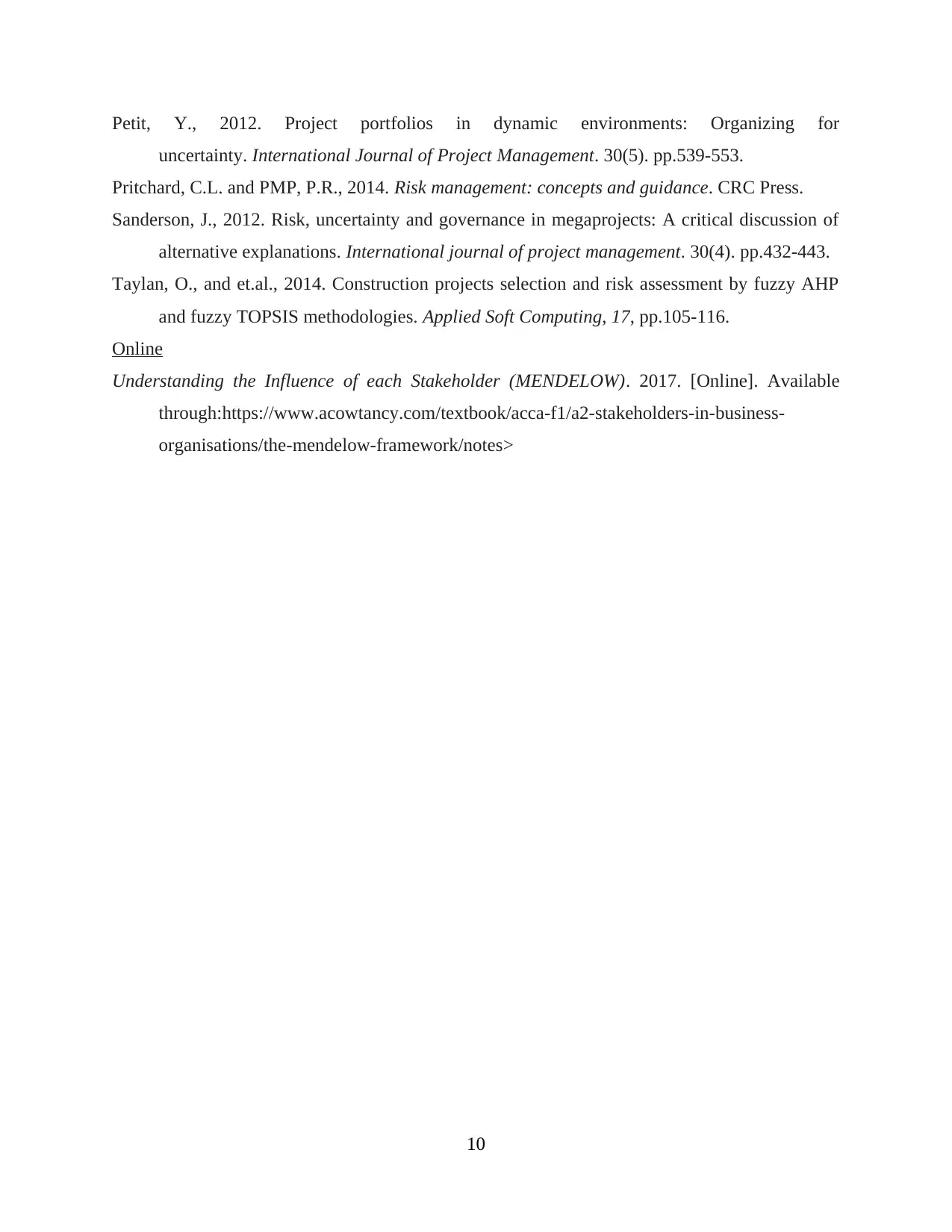
Petit, Y., 2012. Project portfolios in dynamic environments: Organizing for
uncertainty. International Journal of Project Management. 30(5). pp.539-553.
Pritchard, C.L. and PMP, P.R., 2014. Risk management: concepts and guidance. CRC Press.
Sanderson, J., 2012. Risk, uncertainty and governance in megaprojects: A critical discussion of
alternative explanations. International journal of project management. 30(4). pp.432-443.
Taylan, O., and et.al., 2014. Construction projects selection and risk assessment by fuzzy AHP
and fuzzy TOPSIS methodologies. Applied Soft Computing, 17, pp.105-116.
Online
Understanding the Influence of each Stakeholder (MENDELOW). 2017. [Online]. Available
through:https://www.acowtancy.com/textbook/acca-f1/a2-stakeholders-in-business-
organisations/the-mendelow-framework/notes>
10
uncertainty. International Journal of Project Management. 30(5). pp.539-553.
Pritchard, C.L. and PMP, P.R., 2014. Risk management: concepts and guidance. CRC Press.
Sanderson, J., 2012. Risk, uncertainty and governance in megaprojects: A critical discussion of
alternative explanations. International journal of project management. 30(4). pp.432-443.
Taylan, O., and et.al., 2014. Construction projects selection and risk assessment by fuzzy AHP
and fuzzy TOPSIS methodologies. Applied Soft Computing, 17, pp.105-116.
Online
Understanding the Influence of each Stakeholder (MENDELOW). 2017. [Online]. Available
through:https://www.acowtancy.com/textbook/acca-f1/a2-stakeholders-in-business-
organisations/the-mendelow-framework/notes>
10
⊘ This is a preview!⊘
Do you want full access?
Subscribe today to unlock all pages.

Trusted by 1+ million students worldwide
1 out of 12
Related Documents
Your All-in-One AI-Powered Toolkit for Academic Success.
+13062052269
info@desklib.com
Available 24*7 on WhatsApp / Email
![[object Object]](/_next/static/media/star-bottom.7253800d.svg)
Unlock your academic potential
Copyright © 2020–2025 A2Z Services. All Rights Reserved. Developed and managed by ZUCOL.





